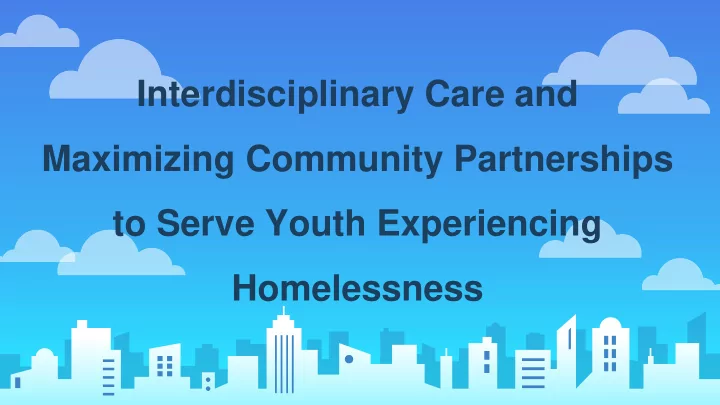

Interdisciplinary Care and Maximizing Community Partnerships to Serve Youth Experiencing Homelessness
2 Agenda Who We Are Defining Homelessness Interdisciplinary Care Community Partnerships This activity is made possible by the Health Resources and Services Administration, Bureau of Primary Health Care. Its contents are solely the responsibility of the presenters and do not necessarily represent the official views of HRSA.
3 Poll 1 Select your primary role at your organization.
4 www.nhchc.org Technical Assistance & Training Medical Policy & Advocacy Research Respite Clinicians’ Network Supportive Housing
5 40,799 Unaccompanied youth 185,000 Families with children 22,000 Families with youth parent 1 The U.S. Department of Housing and Urban Development. (2017) The 2017 Annual Homeless Assessment Report to Congress.
6 1,366,520 Students Experiencing Homelessness 2015-2016 School Year https://eddataexpress.ed.gov/data-element-explorer.cfm
Defining Homelessness Depends … but “instability of living arrangements” is critical
8 Poll 2 Does your clinic assess housing instability?
9 “ “without permanent housing who may live on the streets; stay in a shelter, mission, single room occupancy facilities, abandoned building or vehicle; or in any other unstable or non- permanent situation.” Section 330 of the Public Health Service Act (42 U.S.C., 254b)
10 “ "an individual who lacks housing (without regard to whether the individual is a member of a family), including an individual whose primary residence during the night is a supervised public or private facility (e.g., shelters) that provides temporary living accommodations, and an individual who is a resident in transitional housing." US Department of Health and Human Services Defined in section 330(h)(5)(A)
11 “ “lack a fixed, regular, and adequate nighttime residence,” including sharing the housing of other persons due to loss of housing, economic hardship, or similar reasons; living in motels, hotels, trailer parks, or campgrounds due to lack of alternative accommodations; living in emergency or transitional shelters; and living in cars, parks, public spaces, abandoned buildings, substandard housing, bus or train stations, or similar places.” The McKinney-Vento Homeless Assistance Act (42 USC 11302)
12 “ An individual may be considered to be homeless if that person is "doubled up," a term that refers to a situation where individuals are unable to maintain their housing situation and are forced to stay with a series of friends and/or extended family members. In addition, previously homeless individuals who are to be released from a prison or a hospital may be considered homeless if they do not have a stable housing situation to which they can return. HRSA/Bureau of Primary Health Care, Program Assistance Letter 99-12, Health Care for the Homeless Principles of Practice
13 Interdisciplinary Care The physical, psychological, and social factors that effect youth are inseparable in practice and are best addressed by well-coordinated interdisciplinary teams.
14 Working with Trauma-Informed Youth Experiencing Homelessnes Child-Centered s
15 Give options, not advice (unless they ask) Medical Services Sexual Health Mental & Behavioral Health Acute v chronic Screen for risk (STI/D, conditions violence) Mood disorders Rashes, skin infections Survival sex Suicidality Bug bites Contraception Substance Use Lice, scabies Pregnancy Harm Reduction Models & MI Oral Health National Network for Youth (NN4Y) 24/7 crisis lines Optometry Trauma Rx and follow-up
16 A necessary supplement Social and Support Services Healing Arts and other Creative Interests Housing assistance Variety (Writing, Music, Sports, Theatre) Peer support Technology, the internet and social Case management media Nutrition Civic activities and community Family reunification Entrepreneurship Work/career counseling Gardening Legal service, benefits Bodywork
17 Community Partnerships it is unrealistic to expect any one provider or agency to be able to meet all the needs in any situation. ..
18 Poll 3 Who are your partners? (Select all that apply.)
19 Education ▫ Schools, local school district liaisons, other local education and vocational programs ▫ National Association for the Education of Homeless Children and Youth (NAEHCY) ▫ Youthbuild
20 Homeless Service Providers ▫ Drop-in Centers – rest, eat, shower ▫ Centers that specialize in serving LGBTQ youth ▫ Runaway Homeless Youth programs – street outreach, emergency shelters, longer-term transitional living, and maternity group home ▫ Local transit authorities & law enforcement
21 Community Resources Universities and Volunteers Religious Organizations Colleges For unique services Meals and shelter Interns Legal services Therapeutic services Shelters & Housing Local and Federal Food Banks Programs RHY Food insecurity DV shelters NN4Y Family NAEHCY Youth emergency HCH Transitional
22 Health Care for the Homeless Grantees
▪ Start with a quick assessment of community partners 23 ▪ Consider the role of the mission statement Final Thoughts ▪ Utilize your employees’ network and ▪ Feelings of competition (for funding) may get in the way of Quick Tips healthy partnerships. ▪ MOU/A are used to formalize partnerships. ▪ Direct service providers v administrators roles in these partnerships ▪ Be referral source for your partners ▪ Interagency collaboration ▪ Collaborating agencies are places to engage current or potential consumers. ▪ Collaborations help communities to not “reinvent the wheel” ▪ If two agencies provide the same services near the same location, this benefits the young person.
Recommend
More recommend